Rhinoplasty in Temecula
A surgical procedure designed to reshape or enhance the appearance and functionality of the nose, helping individuals achieve their desired aesthetic or address issues like breathing difficulties.
Rhinoplasty Procedures in Temecula, Murrieta, and Menifee
Rhinoplasty is more than just a cosmetic procedure; it’s an opportunity to enhance your confidence and improve your quality of life. Whether you’re looking to refine the shape of your nose, correct asymmetry, or address functional concerns like breathing difficulties, rhinoplasty can provide transformative results. By achieving a balanced, natural-looking appearance, many patients find that this procedure not only enhances their facial harmony but also boosts their self-esteem. With expert care and attention to detail, our team is dedicated to helping you achieve your desired outcome safely and effectively.
Choosing rhinoplasty is an investment in yourself. Whether your goal is to correct a congenital condition, repair trauma, or achieve a more proportional aesthetic, this procedure offers tailored solutions for your unique needs. At Newman Plastic Surgery, we prioritize your comfort and satisfaction, guiding you through every step of the journey. With our experience and commitment to excellence, you can trust us to deliver results that look and feel natural, helping you feel your absolute best.
What To Expect
- Anesthesia: General
- Length of surgery: 1-3 hours
- Outpatient/Inpatient: Outpatient
- Recovery: 1-2 weeks off work, no strenuous activity for 4 to 6 weeks, full recovery can take up to 12 months
See the Results
Our before-and-after photo gallery showcases the transformative results achieved through rhinoplasty at Newman Plastic Surgery. These images highlight the expertise of our surgical team and demonstrate the natural-looking outcomes we strive for with every patient. Viewing these examples can help you envision what’s possible and give you confidence in taking the next step toward achieving your aesthetic goals. Each transformation reflects our commitment to personalized care and precision, ensuring results that harmonize beautifully with your unique facial features.
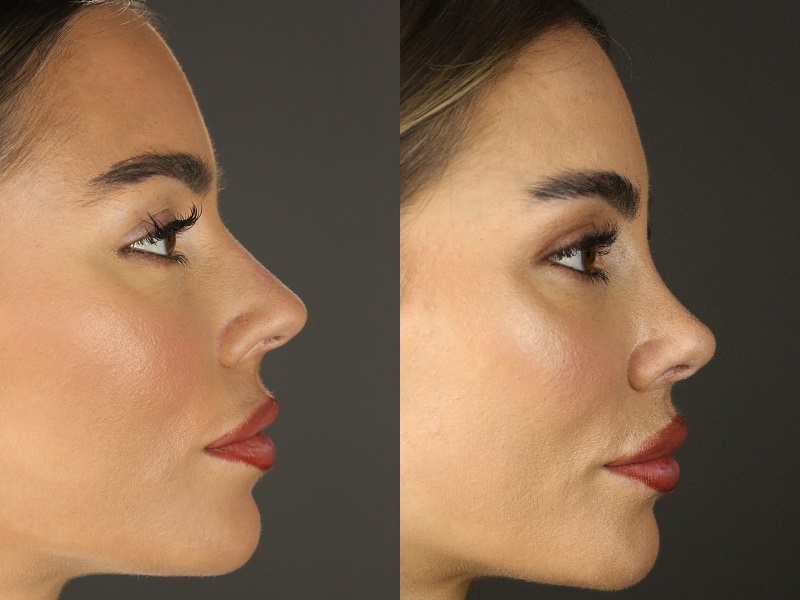
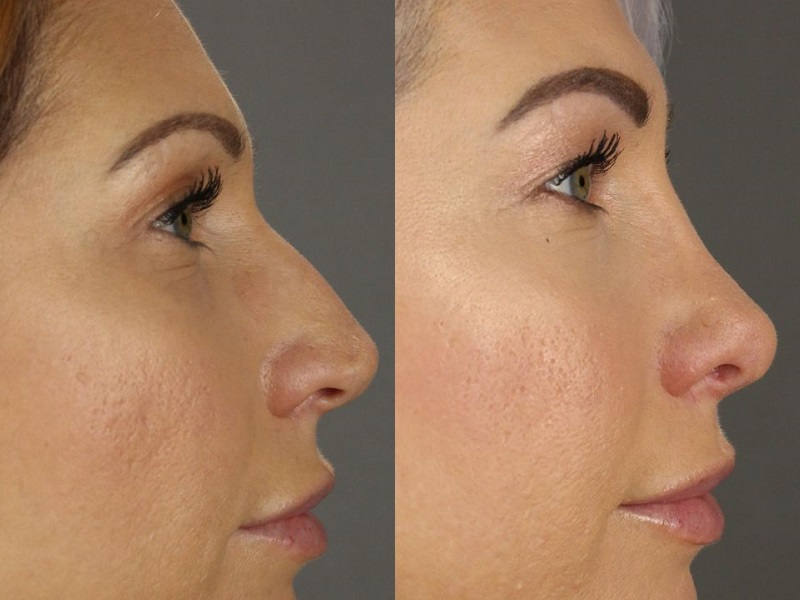
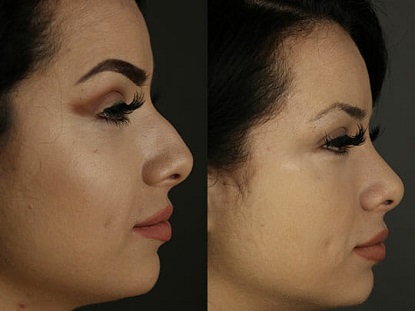
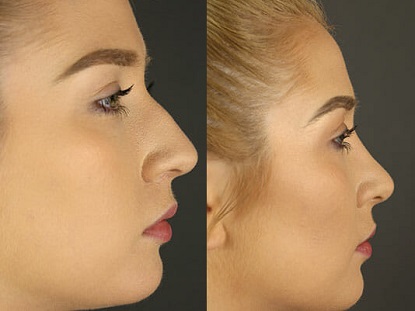
Patients usually seek a consultation with Dr. Newman at Newman Plastic Surgery to reduce the size of their nose and enhance its shape. Dr. Newman makes a thorough and complete checklist of the patient’s wishes for the desired nasal shape. He then loves to draw the patient’s nose from different angles to illustrate what is happening with the nasal shape and as well as discuss the treatment plan.
Drawing and discussing provide a deep understanding of what issues are affecting the shape and give a realistic understanding as to how the patient’s nose can be changed to get them to their goals. Dr. Newman will discuss the alternatives for improvement and recommend the best option.
At your consultation, Dr. Newman will get your thoughts on what you don’t like about your nose and how you want it to look. He loves to draw the nose from different angles and this serves as a springboard to discuss how the nose can be changed and helps patients to share in the creative process. Dr. Newman will offer his opinion on not only how goals can be met but also how to elicit beauty from the patient’s current nasal shape. He will also strive to bring the nose into harmony with the rest of the face and share his thoughts on this issue. Dr. Newman feels that simply taking a photograph and morphing it on a computer is not that enjoyable or predictive and drawing the patient’s nose lends a much richer experience.
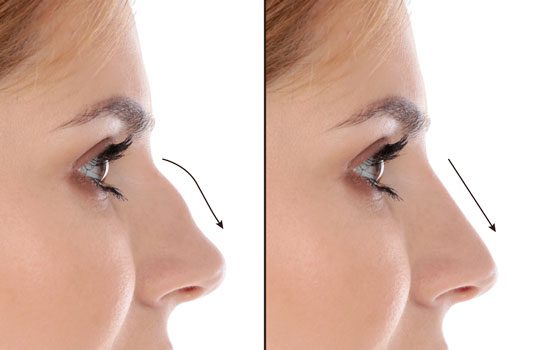
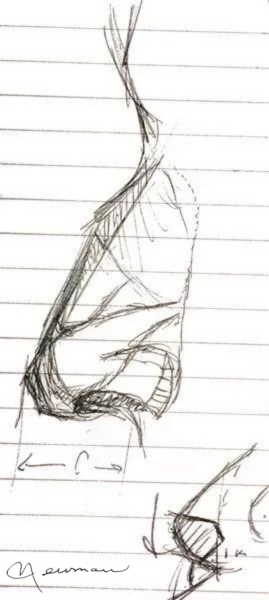
The nose has its own mini-architecture so drawing the nose gives patients a deeper and more gratifying sense of understanding as well as provides a realistic appraisal as to what can be accomplished for each patient based on their nasal anatomy. The entire experience is and should be fun and Dr. Newman is dedicated to helping each patient get the most from this adventure.
At the end of your procedure and before you awake, a small plaster of Paris splint will be sculpted onto the nose to maintain its position. Also, a tiny pack will be placed only within the nostril (and not up the nose!) Patients can sometimes breathe through their nose around the small pack. The next morning, the small packs are removed but the splint is kept in place for six days. Patients often can immediately see changes in the shape of the nose the morning after their procedure and can see that the tip is smaller, softer, and less projecting and they can get a sense that the bump is gone.
While the splint is still on, patients can clean the edge of the nostril with soapy Q-tips and use Vaseline to keep the area moist. Most patients don’t schedule important functions while the splint is on as it brings attention but they can walk outside and perform most of their usual activities. It’s very important to keep pets from jumping up towards the face and workouts at the gym are not commenced for at least three weeks.
At six days after your rhinoplasty, the splint is removed and the sticky substance from the splint that coats the skin can be gently removed with alcohol wipes. With the splint unveiled, patients now see that the bump is gone and the nose already looks smaller. For the next three or so weeks, swelling of the skin in the bump area and on the sides of the nose comes down and patients can begin to see their new nasal line which is that beautiful straight line that moves from the inner edge of the eyebrow to the nasal tip. After this three-week period, the tip is still swollen and it takes longer for tip swelling to go down than in the upper nose. It depends on the initial size of the tip but many patients see that the tip is smaller than it was prior to surgery even at three weeks. It takes at least a full six months to see the final shape of the tip because of this lag in the decrease in swelling of the tip as compared to the upper nose swelling. But after the three-week period, and as the tip is already smaller than it was preoperatively, swelling of the tip is mostly only noticed by the patient.
After Temecula rhinoplasty, patients are back to jogging and other aerobics at about three weeks. Heavy lifting is discouraged for about six weeks when full workouts can be done. During rhinoplasty (nose job), the thin nasal bones are moved to create a more beautiful and elegant form. These bones have the power to heal very quickly and are mostly “set” at two weeks but it is very important for patients to avoid the possibility of contact with the nose for six weeks. By that time, the bones are fully healed.
Since it probably takes a few months until patients will be happy with their photographic image, it may be most wise to schedule rhinoplasty for that amount of time prior to any major event such as a wedding. Another common scheduling idea is to have the procedure prior to a transition to a new environment. For example, some patients have their rhinoplasty at the end of high school or during the summer prior to going to college or beginning work.
Temecula Rhinoplasty surgery is a small surgery but can lend significant improvement to nasal shape and the rest of the face. Enjoying the process can help in great results
Rhinoplasty FAQs
What is rhinoplasty?
Rhinoplasty surgery involves changing the appearance of the nose. The term most people use for rhinoplasty is “nose job” and it is so commonly used now that it has become as accepted as the word rhinoplasty. Rhinoplasty is not a specific surgery but a collection of surgical techniques. Therefore, the term “rhinoplasty” really reflects a field of endeavor, all of whose goals are to improve nasal shape.
What is nonsurgical rhinoplasty?
Nonsurgical rhinoplasty involves the use of fillers to change the appearance of the nose. Filler material can last up to a year and is generally used to mask or disguise issues of the nose. The most common use for fillers to achieve these results is their use in treating the “bump” on the nose. Filler can be applied above and below the bump to make the bump appear more flat. The benefits of filler when they are used are that the procedure is not surgery and so no anesthesia is required. The filler material itself has anesthetic in it and so placement of filler can be done in the doctor’s office. Patients can also visualize what it might look like if there were no bump and then they could then opt for rhinoplasty where the treatment would be complete and no further treatment required. The downside of filler treatment of the nose is that, though it minimizes shape problems, it may not completely solve the issue and because volume is being added to the nose, the nose may appear slightly larger. This last point is important because most patients who come for rhinoplasty feel that their nose is too large. Rhinoplasty surgery reduces the size of the nose evenly and create harmony of the parts of the nose.
What is an open rhinoplasty?
The majority of rhinoplasties are performed”closed”. In a closed rhinoplasty, al or almost all of the treatment is done on the inside and there are no outside scars. Major changes can be made with closed rhinoplasty and most cosmetic issues can be treated successfully in this fashion. There are more difficult problems, for which the alternative, open rhinoplasty may be a better alternative. These problems often center on the nasal tip and especially where the nasal tip does not stick out enough (project enough). In this case, cartilage grafting may be required to bring out the tip and this is best done with open rhinoplasty. Open rhinoplasty may also be a better option for patients when the tip is asymmetrical or uneven. The benefits of open rhinoplasty are that more complicated issues can be addresses. The disadvantages of this procedure are that swelling can last much longer than with the closed technique and that there are more complications. A thorough discussion with a rhinoplasty surgeon that can do both open and close techniques can help patients understand what may be a better option.
What can be done for nostril flare?
Some patients note that they want a rhinoplasty and one issue they see on their nose is that their nostrils seem to flare out and are wider and don’t harmonize with the rest of their nose. In this case a procedure called a “Weir Resection” can be done. This involves removal of a wedge of skin from the nostril where the nostril meet the cheek on the outside. This puts a scar on the outside of the nose but it is generally hidden in a crevice and so can’t be seen. Weir Resection can bring evenness and harmony to the nose and can make the rhinoplasty result more complete.
How long does it take to heal from a rhinoplasty?
Healing for rhinoplasty is relatively quick. Swelling and bruising are generally minimal and rhinoplasties don’t hurt. Patients usually need to wear a splint for six days which can look pretty knarly and so after a rhinoplasty patients are not usually attending social gatherings. But the day after surgery patients can walk outside with a hat and can do most of their usual daily activities. Patients are generally able to drive in a few days after their procedure. Sports are generally resumed at two to three weeks and it’s a good idea for patients not to wear glasses for six weeks as they can press on the part of the nose that was shaped by the procedure.
Can rhinoplasty fix breathing problems?
Rhinoplasty procedures themselves are really done for cosmetic purposes. When patients have cosmetic issues they wish changed with a rhinoplasty, the breathing problems can also be worked on. Those problems might include a “deviated” septum and enlargement of the turbinates. These structures are found inside of the nose and when they are enlarged or bent they can block the airway and make it difficult to breathe. The septum also supports the nose itself and so when patients have both a cosmetic and a breathing issue, it is important to carry out the two surgeries together to get the best results.
What Our Patients Are Saying
Rhinoplasty Reviews
“I have had considerable damage to my nose due to Basel/squamous carcinoma cancer, which resulted in a build up of scar tissue after numerous mohs surgeries. Dr Newman knew exactly the procedure that would be necessary to reconstruct my nose. I’m 100% pleased with the results, not to mention post surgery and the follow up visits. Personable, reassuring, honest, sincere and I might add an appropriate sense of humor, that’s is Dr Newman. Don’t waste your time and energy looking for that perfect plastic surgeon as I highly recommend Dr. Newman.”
Lance J. Danks

“Thank you to Dr. Newman for making my biggest insecurity go away! My whole life growing up I never liked the huge bump on my nose. I had always told myself for years, “one day I’m going to have a rhinoplasty done”. Until earlier this year I made the decision to book a consultation & stop day dreaming about it. I researched a lot of different doctors all over Southern California & based off before and after pictures and all the amazing reviews my attention kept going back to Dr. Newman. His clients rhinoplasty’s looked like natural beautiful noses! Another huge plus was compared to all the other doctor offices, his is only a 10 minute drive from home. Dr. Newman & his staff are very welcoming and educate you on the anatomy so you understand what, why and how. I instantly fell in love & made the appointment. I was very nervous & excited the morning of my surgery, but the staff was amazing & made my nerves go away and assured me that everything will be alright & come out amazing. Today, I love my nose! I get compliments on it all the time & when I make the comment saying I had a rhinoplasty done everyone is always surprised because of how natural my nose looks no one would ever guess I had surgery done. I am so thankful I found Dr. Newman & his amazing staff.”
Elly Ortiz

“Dr. Newman is an AMAZING surgeon. He is very knowledgeable and confident in his work. I trust his opinion and suggestions. Anyone who is looking a for a surgeon you can trust, especially with your body as well as anything else you would like to perfect about yourself… he is your man without a doubt. Enjoy!!!”
Christina Ruiz

“Dr Newman is an excellent plastic surgeon I am so pleased with my results. He is wonderful with explaining the before and after to me. His Staff is so friendly and helpful they made me feel right at home. I highly recommend this doctor.”
Gabrielle Dolce

“Dr. Newman is Such a great Doctor!! Very professional and honest. Love his staff and how friendly they are every time I go into his office. I recommend Dr. Newman to anyone wanting plastic surgery. He will do an amazing job!!”
Amy U

“Dr. Newman is absolutely amazing!!! He really takes his time to help and figure out what you need and what’s best for you. I’ve had some plastic surgeries in the past and no one has ever taken the time and notes like Dr. Newman. And to top it off his staff is seriously the nicest people I’ve ever met. Always working around your schedule to get you in. Thanks again!!
Mandy”
Mandy

